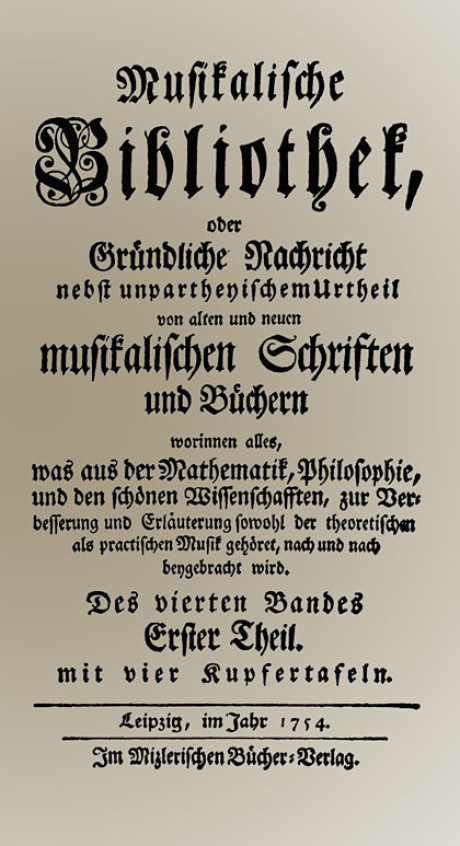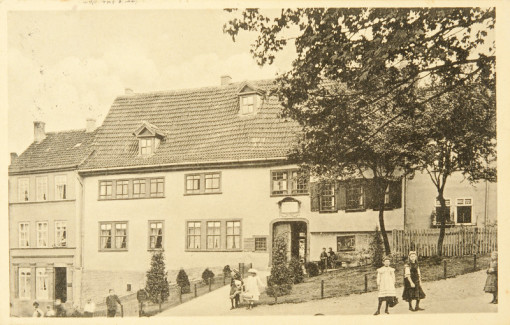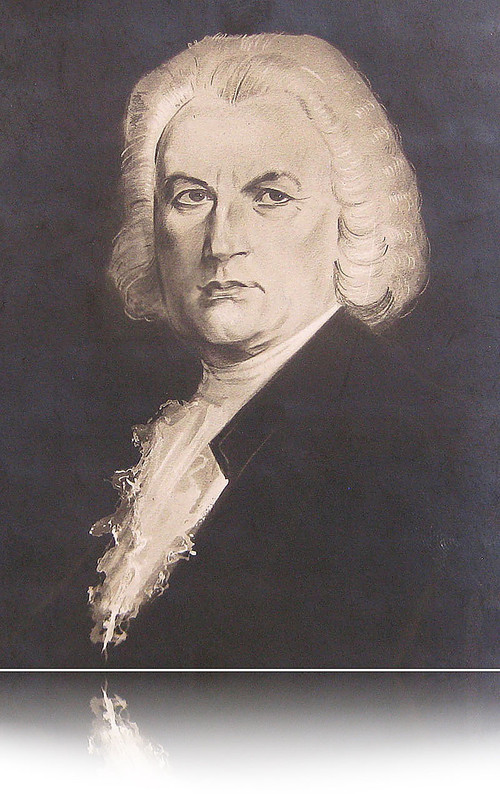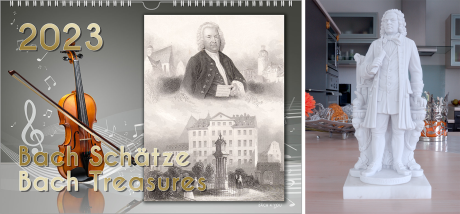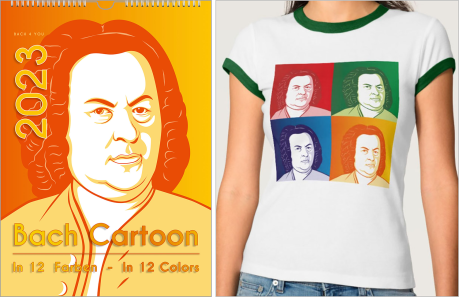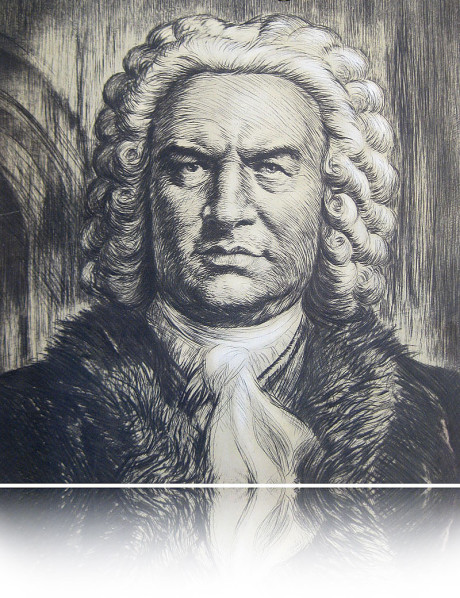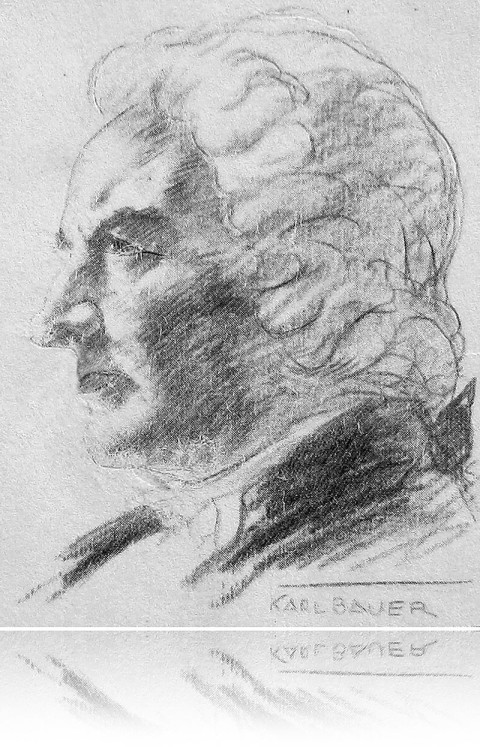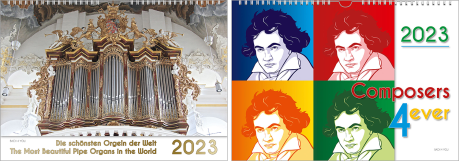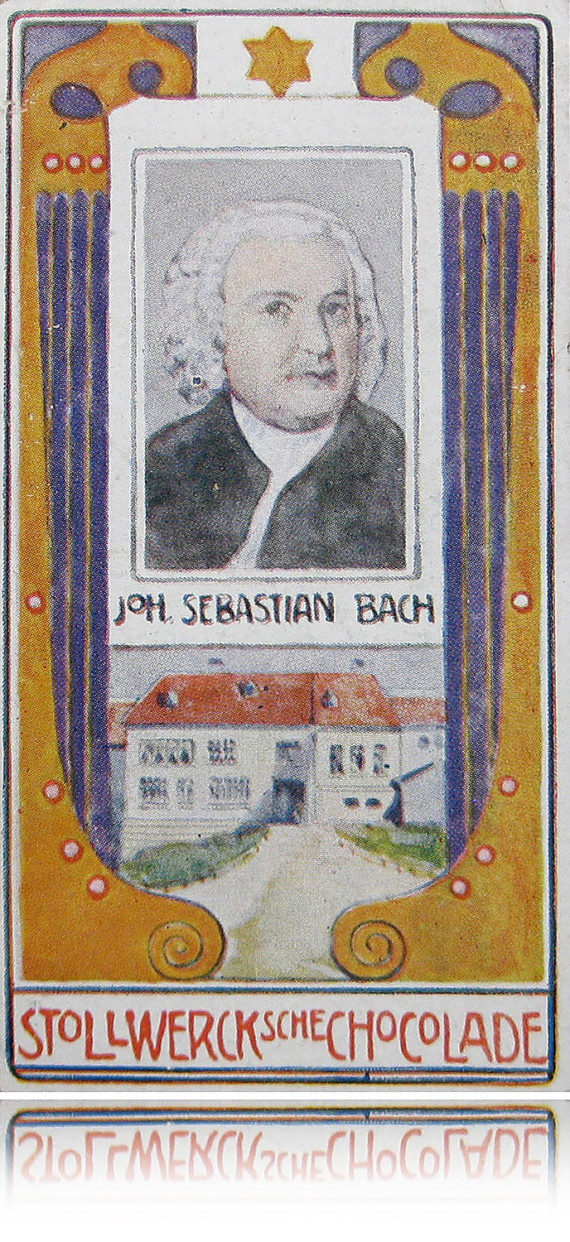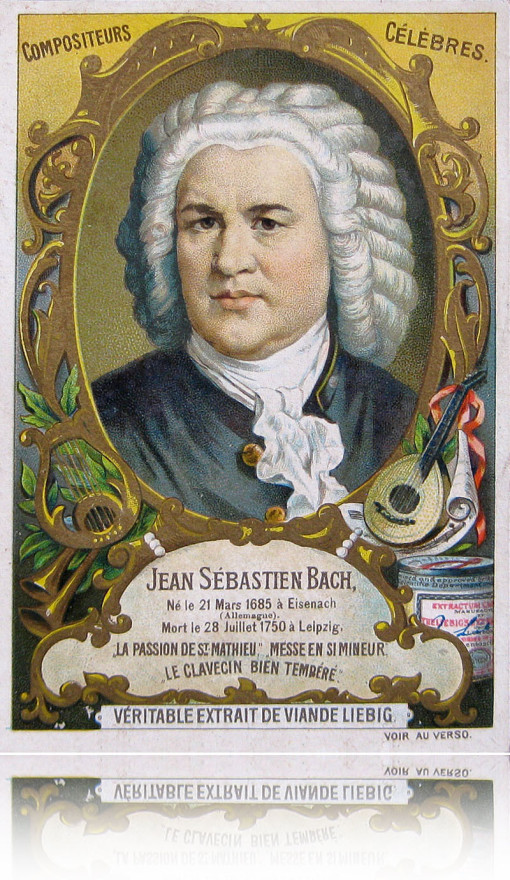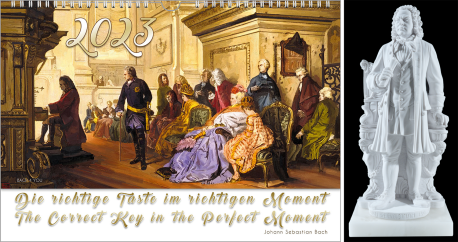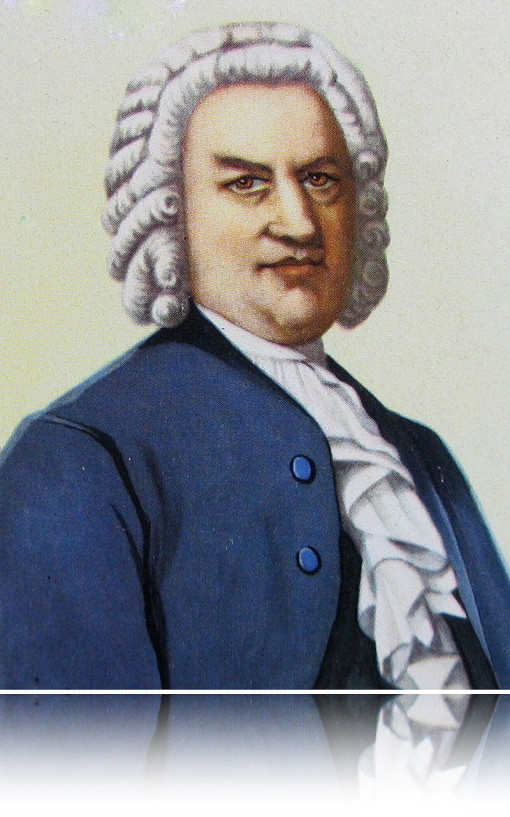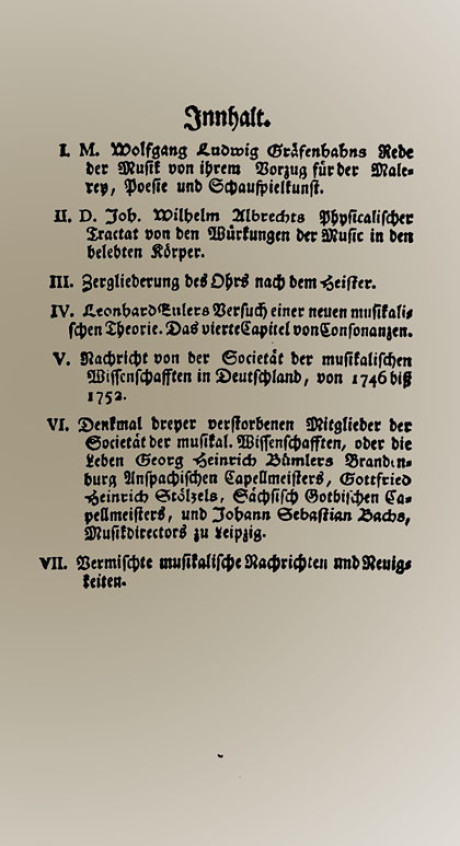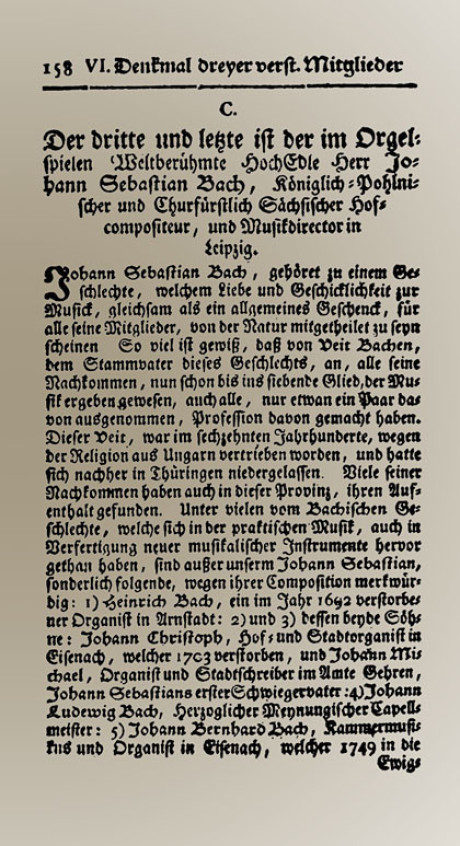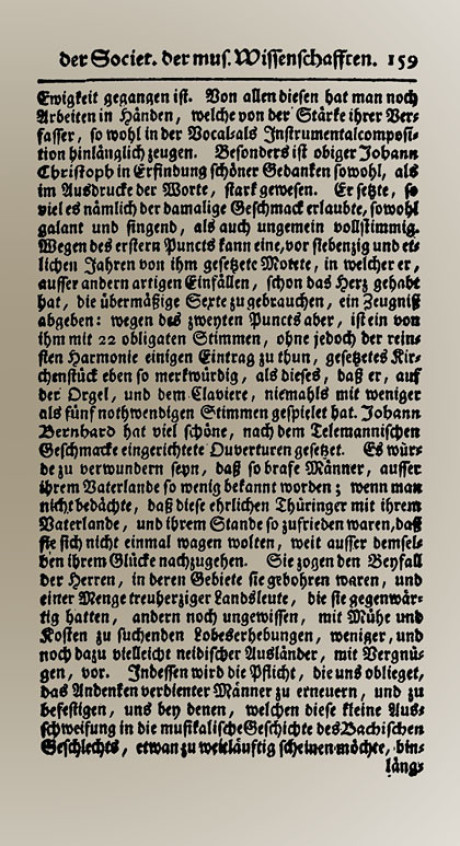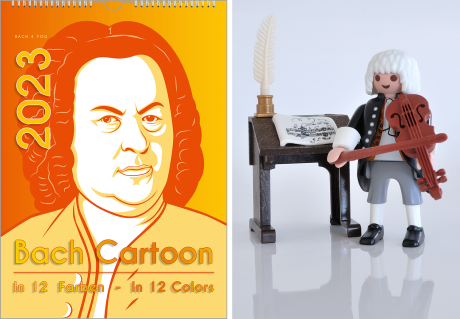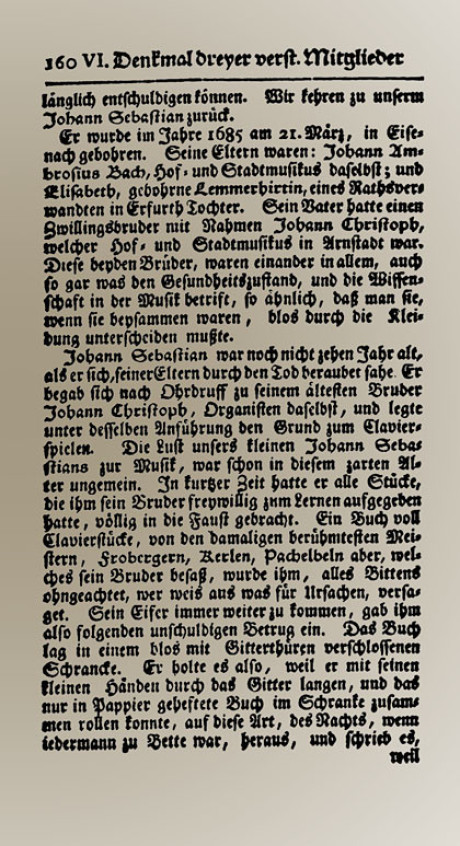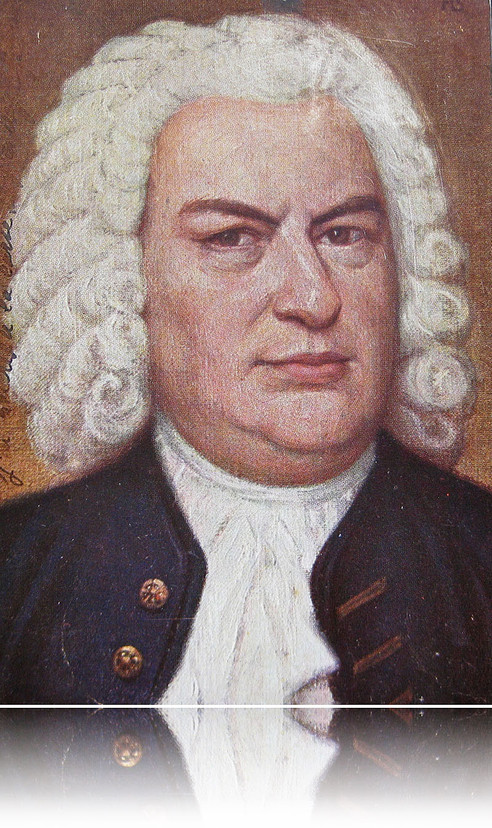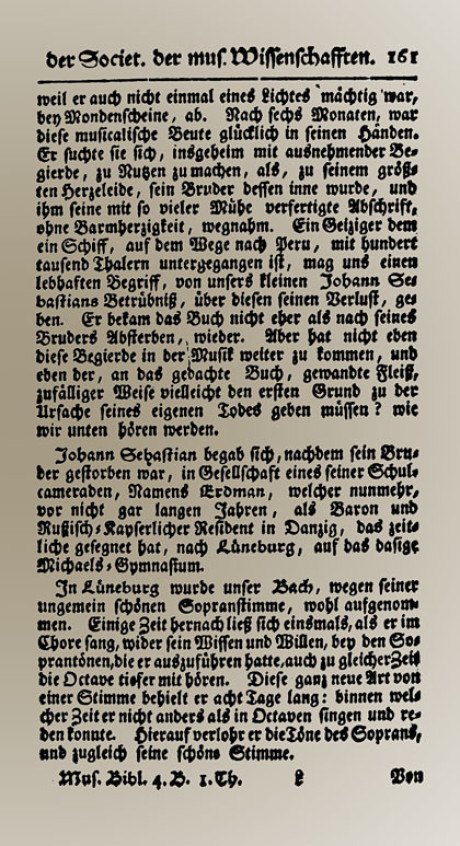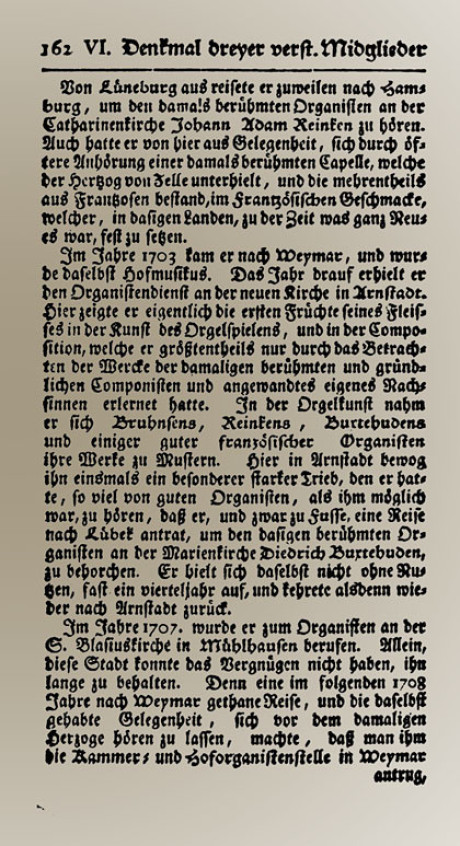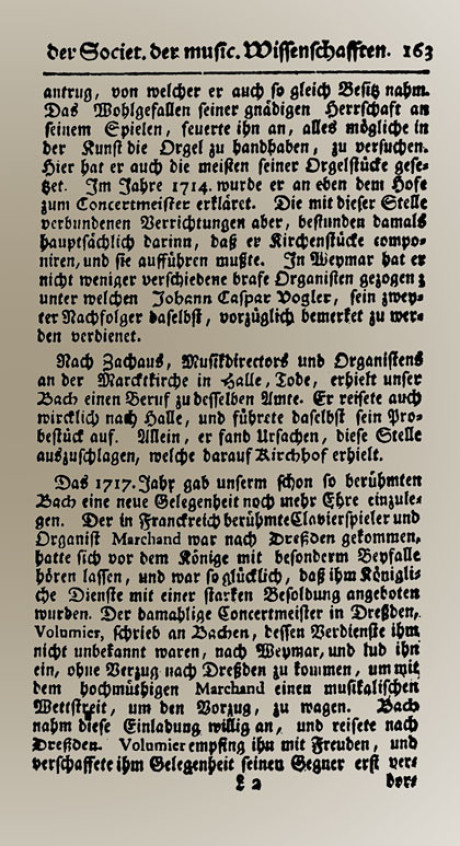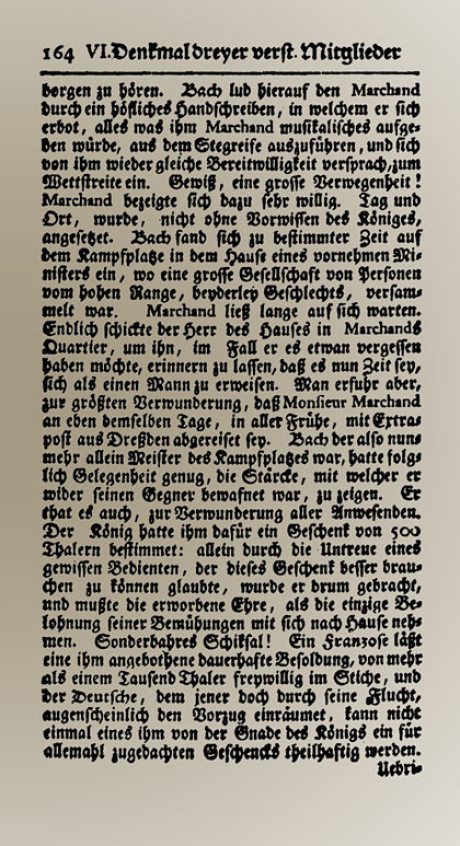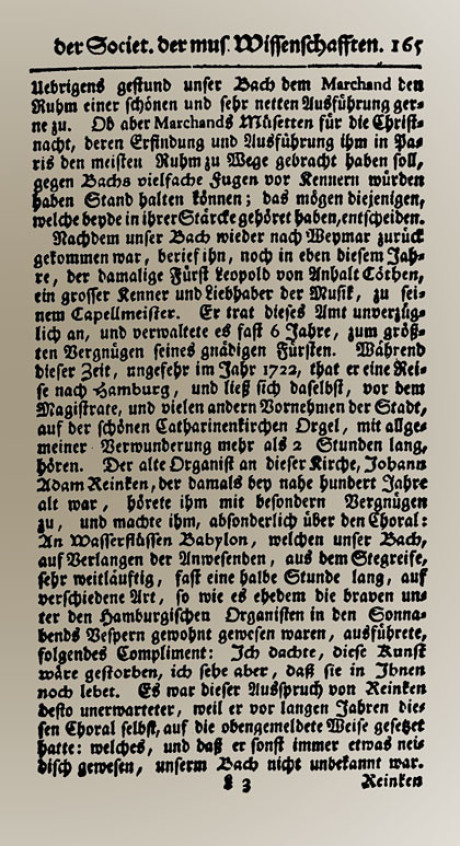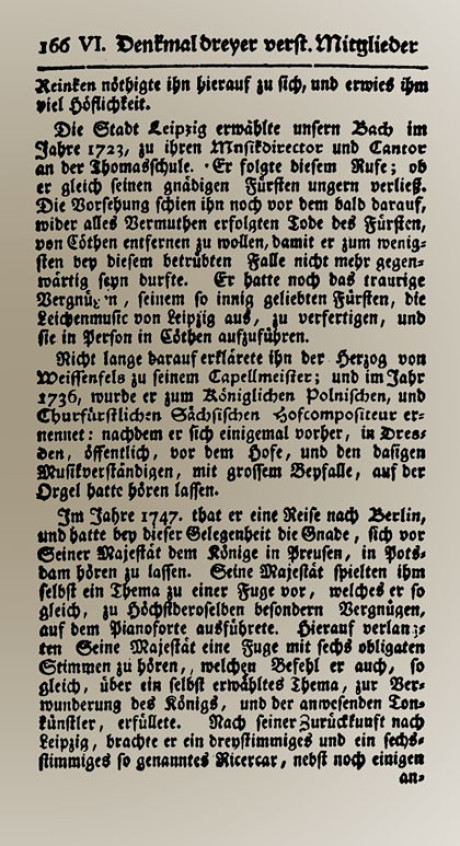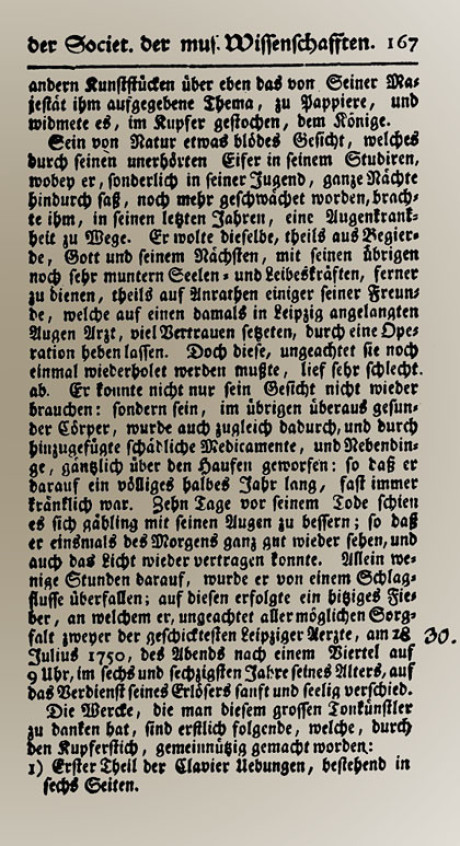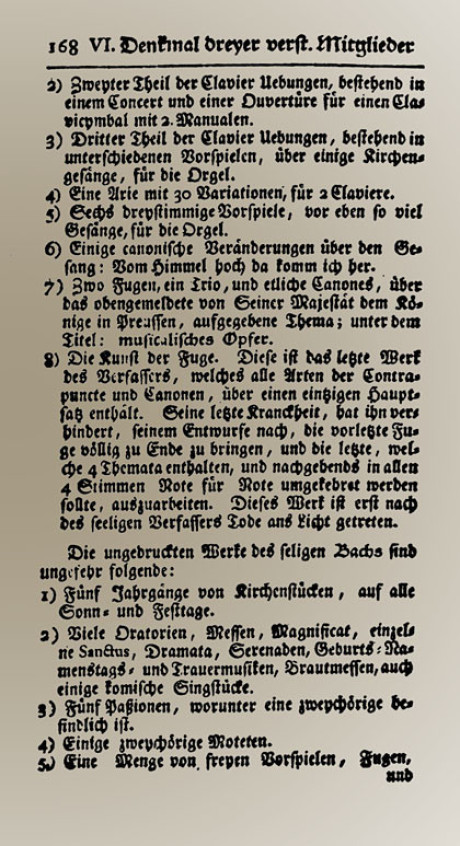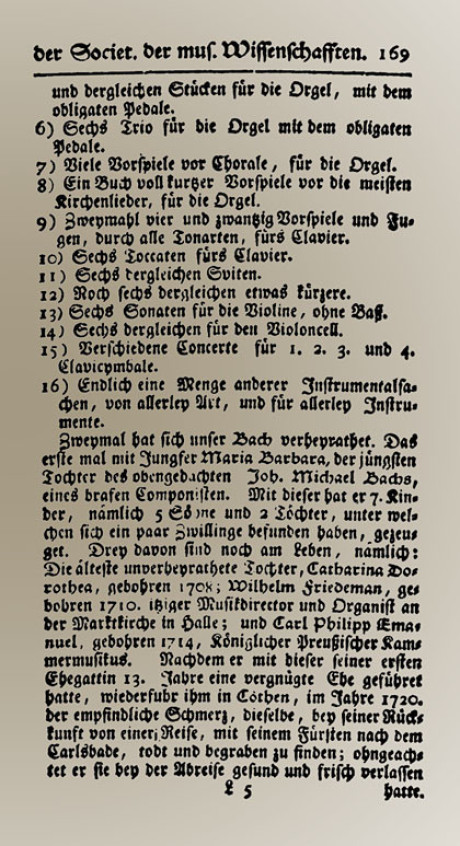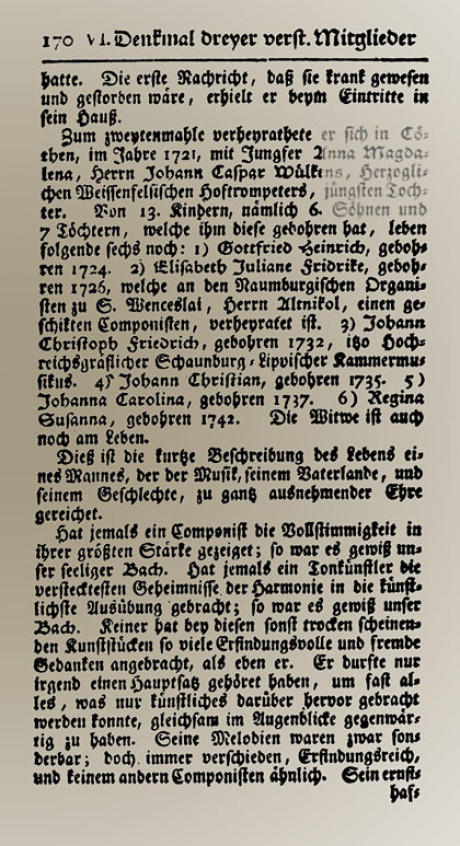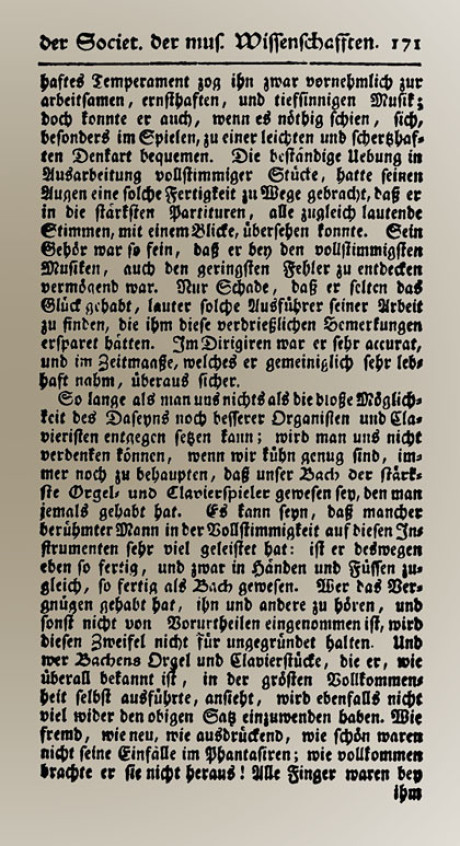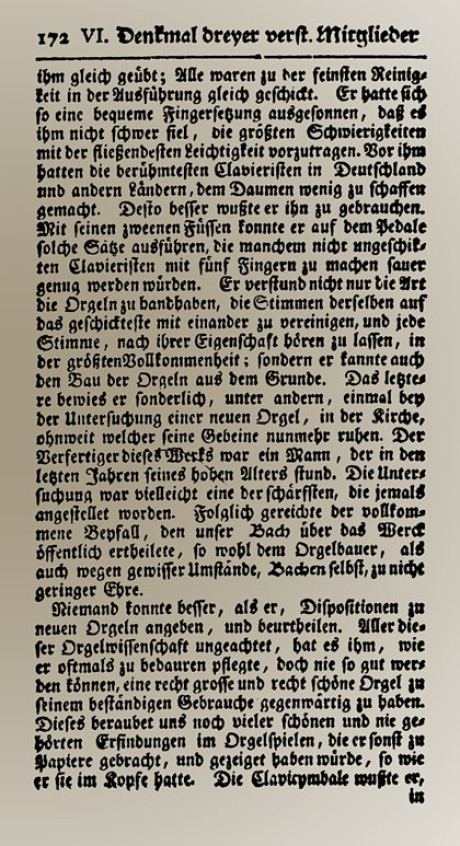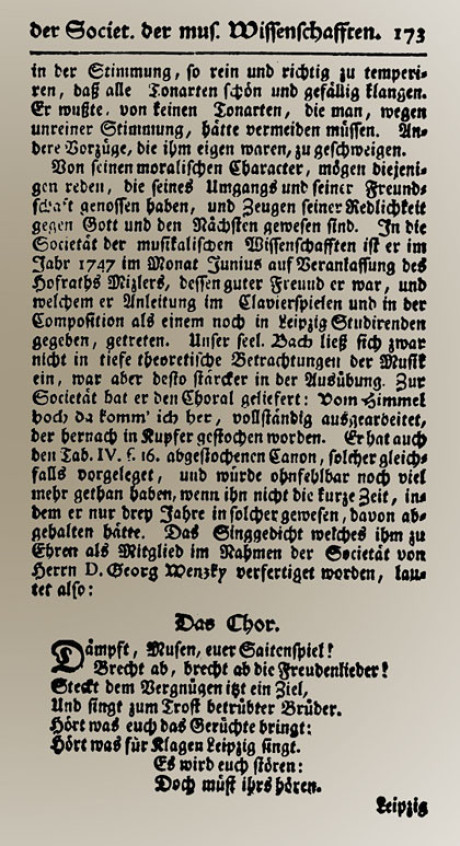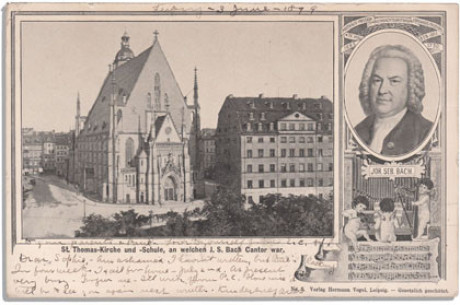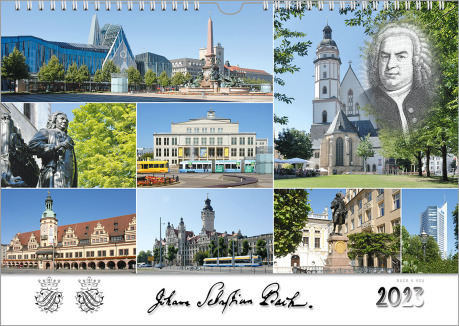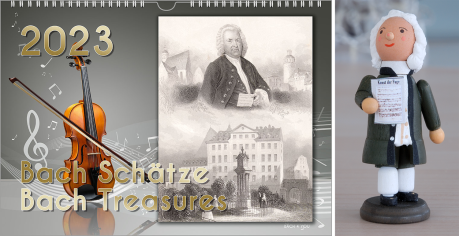The Necrology / Obituary 1750 on Johann Sebastian Bach
Cover of the magazine "Musikalische Bibliothek" with the Necrology / Obituary on Johann Sebastian Bach inside. Actually, for us, it's a time travel 300 years back into the past, when German was not nowadays German and gave us a tough time with translating that all into almost proper English. Please keep in mind: all these illustrations in this chapter didn't come with the original necrology on Johann Sebastian Bach. I added them. The necrology that is just this pages which you see and they are a black and white, no grayish, no brownish.
It goes without saying, that the necrology or obituary on Johann Sebastian Bach mentions the Bach House in Eisenach: it's where the Bach Family once lived, but Johann Sebastian Bach was not born in this house at the "Frauenplan." However, he was born just one minute walk away.
Advertisement
... or You Enjoy the Necrology as a 60-Minute Audio Book with the Music of Bach
Just listen to it for a few minutes. Have fun. And here is the link to the complete work. With your purchase you also support our Bach mission. Click here to go to the perfect place in the shop.
End of Advertisement
The chapter "Necrology" respectively "Obituary" on Johann Sebastian Bach is illustrated with several portraits of the famous composer. Did you know that the Bach House in Eisenach hosts the most extensive collection of priceless portraits of the musician? And if so, did you know that almost none of them represents what Bach looked like? Only one painting, which is the artwork of Elias Gottlob Haussmann is considered to show Bach as he looked back then.
The Necrology for Those Really in a Hurry ... Followed by the Original Bach Obituary ...
Necrology was a name back then what we call obituary today. It displayed a person's life and was published, in our case the life of Johann Sebastian Bach in an "efficient news" in the Mitzler Publishing Company. Today precisely this first biography about the most famous composer on earth is hard to find anywhere. Of course, if you do know where – and we do know that in the meantime – but three years ago and on Google, you are at your wit's end soon. The specialty coming with the necrology on Johann Sebastian Bach is, that actually three authors published it together. First to name, there is Johann Sebastian Bach's son Carl Phillip Emanuel. Next is the founder of the Mitzler Society, Lorenz Christoph Mizler de Kolof and the third is one of Bach's students, Johann Friedrich Agricola. Three days after Bach's death this necrology was published, but a broad public learned about the content as late as three years later.
Here on this website, you may read this necrology in quick twelve minutes transcript, was known about the Thomas Cantor back then. Or you try to understand the old German font original after that from the year 1750. But that might take a while. First you get my translation next.
Advertisement
99 Music Calendars: Pipe Organ Calendars, Composers Calendars, and Bach Calendars
One Important Historical Hint
Please realize that all the illustrations on this page of my website page are not part of the original necrology published in 1750 and 1753, respectively. The original necrology was just a simple script. I added the portraits of Johann Sebastian Bach and the pictures, so there is something beautiful to look at for you.
Page 158:
Johann Sebastian Bach belongs to a group of individuals, who seem to have received their love and skill for music – as a natural gift – for all members. One thing is sure, beginning with Veit Bachen, the ancestor of this dynasty, all his descendants down to the seventh generation, were inspired by music, and all of those, with few exceptions, made music for their profession. This Veit moved in the sixteenth century, from Hungary and settled later in Thuringia, exiled because of his religious beliefs. Many of his descendants continued to live in that area as well. Among the Bach dynasty, many excelled as performing artists, and others specialized in the construction of musical instruments. Besides Johann Sebastian the following are noteworthy for their compositions: 1) Heinrich Bach, an organist who died in Arnstadt 1692 and both sons 2) Johann Christoph, Court and Town Organist in Eisenach, who died in 1703, and 3) Johann Michael, organist and town writer in the office of Gehren, Johann Sebastian's first father in law: 4) Johann Ludewig Bach, Duke Meyningish Bandmaster: 5) Johann Bernhard Bach, Chamber musician and organist in Eisenach, who passed into eternity in 1749.
Page 159:
Of all of those, we have works at hand, which prove sufficiently of the strength of these authors, both in vocal and in the instrumental composition. Especially the mentioned above Johann Christoph is to name strong for both his invention of pleasant thoughts and in the expression of words, He composed, as possible the back-then taste allowed, both gallant and singing, as well as immensely harmonious. Because for the first fact, a motet composed by him seventy and more years ago, in which he, beyond established well-behaved ideas, he had the heart, to use the augmented sixth. However, because of the second point, a composed work from him for 22 obbligato voices, not without the purest harmony, that he, on the organ and on the clavier, never played with less than five parts. Johann Bernhard has composed many beautiful overtures matching to the Telemann taste. It would make you wonder, why such brave men did not become well-known beyond the fatherland. Consider that these honest Thuringians were so happy with their fatherland and their status, that they didn't even try to risk to search for their fortune far beyond their home. They preferred the applause of the gentlemen of their era plus a crowd of trusted fellow countrymen, which they had around with pleasure. Compared to look for an uncertain, with effort and cost related applause, coming from few plus possibly even jealous foreigners. But we have the obligation to renew the memory of honorable men, and to confirm them, and to apologize to those, who may find this little exaggeration a little too long.
Advertisement
Would You Like to Support Our Bach Mission? Yes ... Please with Pleasure!
✓
The "Bach 4 You" publishing house does not only operate one shop on the internet. No, there are five. Here is your choice. The publishing house offers music calendars, composer busts and countless Bach items. "Zazzle" offers brochure calendars (... more popular in the US) and Spreadshirt is the best place to find Bach-related or music-related T-shirts.
End of Advertisement
Page 160:
We now return to our Johann Sebastian.
He was born in the year 1685 on March 21st, in Eisenach. His parents were Johann Ambrosius Bach, court and town musician there, and Elisabeth, née Lemmerhirtin, a daughter of a member of the Erfurt's council. His father had a twin brother with the name of Johann Christoph, who was court and town musician in Arnstadt. These two brothers were so similar in everything, even when it came to the status of their health and the science of music, that you, when they were together, just could only distinguish them by their clothes.
Johann Sebastian wasn't even ten years old when he saw himself robbed of both his parents by death. He went to Ohrdruf to his oldest brother Johann Christoph, who was organist there, and he prepared the foundation to play the piano by his guidance. The desire for the music of our little Johann Sebastian was, even at his tender age, immense. In a short period, he had all the pieces that his brother voluntarily gave him to learn, entirely on his own fist. However: a book full of piano pieces, from back-then most famous masters Froberger, Kerlen, Pachelbel, which his brother possessed, was, without taking notice of all requests, who knows for what reasons, denied. Diligence, to get forward, lead to the following innocent cheating. The booklet lay in a cabinet locked only by a closed grill door. So he took it because he was able to get through the grill with his little hands as he managed to roll the booklet, which was only stapled in paper. In this way, he took it out at night, when everybody was in bed and copied it at moonshine, ...
Page 161:
... as he was not having any of a light. After six months, this musical booty was happily in his hands. He tried, secretly and with increasing ambition, to get use out of it, when, accompanied by his most significant heart suffering, his brother realized the cheating and took the copy which he was written with so much effort, away from him with no mercy. A grasping person, whose ship went under on its way to Peru with one hundred thousand talers on board, may provide an agile idea of little Johann Sebastian's sadness about this loss. He didn't get the book back earlier but after his brother's dieback. But hasn't just this ambition, to get forward in the music and the diligence, when we think about the book, perhaps actually been the first reason for the cause of his own death? As we will hear about later.
After his brother has died, Johann Sebastian went to Lueneburg, to visit the Michaelis College there. He was accompanied by one his schoolmates with the name of Erdmann, who has meanwhile met his maker, not that many years ago, as a Baron and Russian-Emperor resident in Gdansk.
In Lueneburg, our Bach was well accommodated because of his exquisitely beautiful soprano voice. Sometime later, when he sang in the choir, and he did not know it, and he did not want it, the soprano tones, which he had to execute, could be heard at the same time with the octave lower. He kept this very new way of his voice for eight days: while this time he wasn't able to sing nor speak in octaves. After that, he lost both the tones of the soprano and his beautiful voice at the same time.
Portrait No. 2 in the necrology/obituary chapter on Johann Sebastian Bach: an antique Russian painting.
Page 162:
From Lueneburg he traveled to Hamburg once in a while, to listen to the back-then famous organist at the St. Cathryn Church, Johann Adam Reinken. Plus he had the opportunity here, to learn more about the French taste, which was something really new being performed in this country. He had this option through listening several performances of a back-then famous band, which the Herzog of Celle maintained and which were Frenchman for the most parts.
In the year 1703, he came to Weimar, and he became court musician there. In the following year, he got the job of the organist at the new church in Arnstadt. Actually, it was here that he showed the first fruit of his diligence in the art of playing the organ, and in the composition, which he just managed to learn by looking through the back-then famous and efficient composers and executed own meditation. In the art of playing the organ, he did works of Bruhnsen, Reincken and Buxtehude and some French organists models. Here in Arnstadt once an exceptionally strong appetite, which he had, made him listen to as much music as he could possibly get from good organists. Plus, and he did that on his own feet, he made a trip to Luebeck, to listen to the famous organist at the St. Marie Church there, Diedrich Buxtehuden. He stayed there, not without benefit, for almost a quarter of a year, and he returned back to Arnstadt after that.
In the year 1707, he was appointed organist at the St. Blasius Church in Muehlhausen. But this town hasn't had the pleasure to keep him for long. Because a trip to Weimar in the following year 1708 and the opportunity there to be heard by the back-then duke, resulted in an offer to him to get the job as a chamber and court organist and in Weimar...
Page 163:
of which he took possession of at once. The pleasure of his gracious sovereignty with his excellent performance enlivened him to try all sorts of handling the art to play the organ. Here he has set the most of his organ pieces. In the year 1714, he was appointed concertmaster at this court. However, the accomplishments coming with this position was mainly to compose pieces for the church plus he had to perform them. In Weimar he has educated several honest organists, among Johann Caspar Vogler, his second successor deserves to be mention as brilliant.
After the death of Zachaus, music director and organist at the Markt Church in Halle, our Bach received a call for this position. He actually traveled to Halle, and he performed his sample piece there. However he found reasons to reject this position, and Kirchhoff received this job.
The year 1717 presented our already so famous Bach a new opportunity to receive even more glory. The piano player and organist Marchand, who was famous in France had come to Dresden and performed to the King and got special applause. He was so happy that he was offered to execute royal services for a significant payment. The back-then concertmaster in Dresden, Volumier, wrote to Bach, whose merits haven't been unknown to him in Weimar, and invited him, to come to Dresden without delay to perform a musical contest with the arrogant Marchand. Bach accepted this invitation compliantly and traveled to Dresden. Volumier welcomed him with pleasure and gave him the opportunity to listen to his rival covertly at first.
Page 164:
After that, Bach invited Marchand for a contest by a polite handwritten letter, in which he offered, to perform everything that Marchand asks him to play ad hoc if he promised to do the same thing. Certainly a great audacity! However, Marchand was very willing to that. Day and place were set, not without the king knew that in advance. Bach showed up at the arena at the arranged time in the house of an elegant minister, where a large society of persons of high rank, of both genders, was gathered. Marchand kept them waiting for a long time. Finally, the host sent somebody to the accommodation of Marchand to remind him, just in case he forgot, that it's now the time, to prove he is a man. However, they figured out, taken by biggest mystification, that Monsieur Marchand, on this very day, very early in the morning, left Dresden by stagecoach. Bach who now was master of the arena alone, had much chance to show the strength with which he was armed against his rival. And so he did it, just for the amazement of all attendees. The king decided for a gift of 500 Talers for him: Alone by the disloyalty of one particular attendant, who believed to need that gift better, Bach was missing that gift. He had to take the acquired honor as the only payment for his effort back home. Strange destiny! A Frenchman abandoned an offered long-lasting position for more than one thousand talers voluntarily, and the German, who this person offered the advantage with his escape obviously, cannot even get the gift by the grace of the king.
Portrait no. 3 in the necrology/obituary chapter on Johann Sebastian Bach: this one is from Karl Bauer, a German painter.
Page 165:
By the way: our Bach allowed Marchand the glory of a beautiful and a very enjoyable execution. However whether Marchand's musettes for the Christ Night, whose invention and the execution is said to deliver him most of his fame in Paris, would have succeeded against Bach's complex fugues in front of an expert; that might decide those, who have heard both in their strength.
After our Bach has returned to Weimar, still in this year, the back-then sovereign Leopold of Anhalt Koethen, a great expert, and lover of music appointed him his bandmaster. He took his new office without delay and executed it for almost six years, for the highest pleasure of his gracious sovereign. During this time, it was approximately in the year 1722, he made a trip to Hamburg and made himself heard in front of the municipal authorities and many other noble residents of the city on the beautiful organ of St. Cathryn's Church, for general amazement, more than two hours. The old organist in this church, Johann Adam Reinken, who was almost one hundred years of age back-then, listened to him with special pleasure and made him, in particular about the choral "An Wasserfluesen Babylon" a compliment. Our Bach played this piece ad hoc and very spacious for half an hour in different versions, like anciently the honest among the Hamburg organists in the Saturday services were used to do. The compliment was the following: I thought, this art has died out. However, I see now, that it is still living in you. This statement of Reinken was even more unexpected, as he, many years ago, set this choral himself, in the mentioned method above. Which was not unknown to our Bach.
Advertisement
Yes, We Also Offer Music Calendars and Bach Calendars with a Grid
Probably nowhere are there more Bach gifts and above all more Bach figures than in the five internet shops in the publishing house "Bach 4 You".
End of Advertisement
Page 166:
After that Reinken obligated Bach to see him and paid him much cordiality.
The town of Leipzig elected our Bach in the year 1732 as their music director and cantor at the St. Thomas School. He responded to this call; although he left his gracious sovereign unwillingly. The destiny seemed to draw him away from Koethen - even before the death of the sovereign of Köthen against all expected happened - at least he had not to be present and aware of that saddened fact anymore. He finally had the sad pleasure, to create the funeral music for his so beloved sovereign from Leipzig and to perform it personally in Koethen.
Not long after that, the Duke of Weissenfels declared him his bandmaster and in the year 1736 he was appointed Royal Polish and Electoral Saxon Court Composer, after he made himself heard on the organ, in Dresden, several times before publicly, in front of the court and the music experts there, with big applause.
In the year 1747, he made a trip to Berlin and had the grace with this opportunity, to be heard in front of His Majesty, the King in Prussia, in Potsdam. His Majesty himself presented a musical piece for a fugue with six obligatory voices to listen, which he, without delay, for the unique pleasure of his Majesty, executed on the pianoforte. After that, His Majesty demanded to listen to a Fugue with six obligatory voices, which command he as well, about a theme of his own choice, he executed with no delay - taken by the amazement of the king and all present tone artists. After his return to Leipzig, he brought a three voice and a six-voice so-called Ricecar among more...
Page 167:
works of art exactly about this theme handed to him by His Majesty, on paper and dedicated it, engraved in copper, to the King.
His connatural sort of stupid face, which by his outrageous diligence while studying, when he, especially in his youth, sit whole nights trough, weakened him even more, triggered an eye illness in the last years. He wanted to have this corrected by surgery through an in Leipzig arriving eye doctor. He wished that part from his ambition, to serve God and His Next in the future, with his left but very awake soul and body power and part was the recommendation of some of his excellent friends, which put much trust in this eye doctor, who arrived in Leipzig back-then. But this surgery turned out very bad, and he had to have it done again. Not only couldn't he use his face again, but a whole of his actually very healthy body became messed up by the additional taken damaging medicine, and besides things, so that he after this was almost always sickish for a complete half year. Ten days before his death it seemed to get graciously better with his eyes so that he could see once a morning relatively good, and he could get along with the light again. But a few hours later he was attacked by a stroke; this was followed by a hot fever, from what he, regardless of all possible carefulness of two of the most skillful Leipzig doctors. He died on July 28th of the year 1750, in the evening after a quarter to nine, in the sixty-sixths year of his age and passed away gently and blessed by the call of his redeemer.
The works, we should thank this excellent tone artist for, are firstly the following, which are. By the engraving in copper, made of public utility:
1) First part of the Piano Exercises, composed of six pages.
Portrait no. 4 in the Necrology / Obituary chapter on Johann Sebastian Bach: this one is on an antique commercial picture by well-known Stollwerck Chocolate.
Page 168:
2) Second Part of the Piano Exercises, composed in a concert and an overture for a Clavicembale with two manuals.
3) The third part of the Piano Exercises, composed in variable foreplays to some chants, for the organ.
4) An aria with 30 variations, for 2 pianos.
5) Six foreplays in three voices, and the same number of chants, for the organ.
6) Some canonical changes about the chant: Vom Himmel hoch, da komm ich her.
7) Two fugues, a trio and a number of canons about the above mentioned handed theme of His Majesty, the King with the title: Musical Sacrifice.
8) The Art of the Fugue. This is the last work of the author, which contains all kinds of counterpoints and canons about one single main sentence. His last disease has prevented him, according to his concept, to bring the second to last fugue to a complete end and the last, which contains 4 themes and was supposed to be accomplished finally in all 4 voices easing note by note inverted. This work has seen the light not earlier than after the blessed author's death.
The unprinted works of the blessed Bach are roughly the following:
1) Five volumes of church pieces, for every Sunday and festive days.
2) Many oratorios, masses, Magnificat, individual Sanctus, dramas, serenades, birthday-, anniversary- and funeral music, bridal masses and some funny songs as well.
3) Five passions, among them one for two choirs.
4) Some two choir motets.
5) Many of free foreplays, fugues and...
Page 169:
...pieces like this for the organ, with the obligatory pedal.
6) Six trios for the organ with the obligatory pedal.
7) Many foreplays before chorals, for the organ.
8) A book full of short foreplays in front of most of the chants, for the organ.
9) Two times twenty-four foreplays and fugues, through all keys, for the piano.
10) Six Toccatas for the clavier.
11) Six of the same suites.
12) Six more of the same but a little shorter.
13) Six sonatas for the violin, without bass.
14) Six of the same for violoncello.
15) Several concerts for 1, 2, 3 and 4 Clavier-Cymbale.
16) Finally many other different instrumental things, different style, and for several instruments.
Two times our Bach had married. The first time with the damsel Maria Barbara, the youngest daughter of the above mentioned Johann Michael Bach, an honest composer. With her he fathered 7 children, that is to say, 5 sons and 2 daughters, among whom was a couple of twins. Three of them are still alive, and that is to say: The oldest unmarried daughter, Catharina Dorothea, born 1708; Wilhelm Friedemann, born 1710. He is now music director and organist at the Markt Church in Halle; and Carl Philipp Emanuel, born 1714, Royal Prussian Chamber Musician. After he had spent a happy marriage with this, his first wife for 13 years, he experienced a damageable pain in Köthen in the year 1720, after returning from a trip with his sovereign from Carlsbad, when he found her dead and buried, although he as left her at his departure healthy and fresh.
Page 170:
The first news that she has been ill and had died, he received when he entered his home.
A second time he married in Koethen, in the year 1721, with the damsel Anna Magdalena, Mr. Johann Caspar Wuelkens, a Duke of Weissenfels Court Trumpeter's youngest daughter. From 13 children, that is to say, 6 sons and 7 daughters, which she gave birth to, the following six are still living: 1) Gottfried Heinrich, born 1724. 2) Elisabeth Juliane Fridrike, born 1726, who is married to the Naumburg organist at St. Menceslai, Mr. Altnikol a skilled composer. 3) Johann Christoph Friedrich, born 1732, who is a Chamber Musician to the Imperial Count Schaumburg-Lippe. 4) Johann Christian, born 1735. 5) Johanna Carolina, born 1737. 6) Regina Susanna, born 1742. The widow is still alive as well.
This is a short description of the life of a man, who is devoted to the music, to his fatherland, and his gender with an exquisite amount of honor.
Has a composer ever accomplished the polyphony in its greatest strength, it definitely was, no doubt, our blessed Bach. Has a tone artist ever brought the hidden secrets of harmony into the most artistic execution, it was undoubtedly our Bach. Nobody has attached so many thoughts full of invention and external art pieces that seem to be dry without as just he did. He has only heard of any main clause, to be aware of everything about almost everything, which could be artificially brought up at the very same moment. His melodies were strange indeed, but always different, rich in invention, and not similar to any other composer. His serious...
Page 171:
temperament especially tore him to hard-working, serious and profound music; but he was capable as well, if it seemed to be necessary, especially with the play, of presenting an easy going and humorously way to think. The constant practice of creating polyphony pieces has taken his eyes to such a capability, so he was able to overlook into the strongest scores, all the same, conform voices, with one view. His sense of hearing was so keen-eared that he was capable of discovering the smallest mistake with the polyphony music pieces. It just was a pity, that he seldom had the luck, to find all those initiators for his work, who would have avoided this disagreeable comments. In conducting he was very accurate, and in the measure which he generally took very agile, extremely confident.
As long as we don't have the pure possibility of the sheer presence of even better organists and piano players against, nobody would oppose, if we are brave enough, still to claim, that our Bach has been the strongest organ and piano player, whoever was present. It may be, that many a famous man in the polyphony from these instruments has accomplished much: has he, for this reason, been as capable as Bach? Those who had the pleasure, to listen to him and others, and isn't captured by preconception, won't consider this doubt as baseless. And like Bach's organ and piano pieces, which he, that is known everywhere, performed in person to the highest perfection, will again have nothing to argue against the sentence above. How different, how new, how expressing, how beautiful were his ideas of fantasizing, how perfect did he perform them! All his fingers
Portrait no. 5 in the necrology/obituary chapter on Johann Sebastian Bach: an antique French company selling meat extract. The company's name is Liebig.
Page 172:
were practiced in the same amount; all of them had the same capability in the perfection to execute them. He had thought about a convenient finger setting, that it wasn't difficult for him, to perform the most significant difficulties with the most flowing lightness. Before him, the most famous piano players in Germany and other countries made the thumb little to work. But he knew better to use it. With his two feet, he was able to execute such sentences on the pedals, which would be a challenge for many a skilled piano player with five fingers and he would become sour enough. He did not only know how to handle the way of playing the organ, and to combine the sound of it in the most clever way and let every voice sound related to her nature and in the greatest perfection, but he as well knew the construction of organs for this reason. The last mentioned he proofed especially once, among others, with an examination of a new organ, in a church not far from where his remains are put to rest today. The creator of this work was a man, who stood in his last years of his high maturity. The examination was may be one of the harshest, that ever happened. Consequently the perfect applause, which our Bach granted about the work publicly, for both the organ builder and, for particular reasons, for Bach himself as well, to a considerable honor.
Nobody but he could better give dispositions for new organs, and judge it. Regardless of all this organ science, he had – how he used to regret often – never had a rather beautiful and a rather lovely organ present for his steady use. Being robbed from this, he would have left us even more, and pleasant never heard inventions in the organ play, which he would have brought to paper and shown us like he had them in his head.
Advertisement
Thousands of Bach Gifts ... Actually Millions of Bach Gifts. Promise!
Bach calendars and Bach figures, busts and statues: Please support our Bach Mission … learn more.
End of Advertisement
Page 173:
He knew to temper the claviercymbale in the atmosphere so pure and correct that all keys sounded nice and accommodated. He knew of his keys, because of their abominable temper, which should have to be avoided. And there were other advantages, which he had.
Those may talk about his moral character, who enjoyed his acquaintance and his friendship and have become a witness of his honesty against God and the next. He joined the Partnership of Musical Science in the month of June in 1747 at the instigation of Court Counsellor Mitzler, who was his good friend, and who he thought to play the piano and who he advised how to compose when he still was a student in Leipzig our blessed Bach didn't sink in the deep theoretical observation of music, but even more in the execution. He delivered the choral to the partnership: Vom Himmel hoch da komm ich her, wholly finalized, which after that became an engraved in copper canon. He would, without question, have even done much more, if he wouldn't have been held from accomplishing that, as he was in that partnership only the short time, of three years. The singing poem, which they presented him as an honor as a member of the association – Mr. Georg Wensky created it – is then:
The Choir
Absorb, muses, your string play!
Stop, stop the songs of joy!
And sing as a consolation for sorrowful brothers.
Hear what the rumors bring:
Hear what complains Leipzig sings.
It will trouble you:
But you have to listen to it.
Portrait no. 6 in the necrology / obituary chapter on Johann Sebastian Bach: it's antique but the background is unknown.
The Original Necrology on Johann Sebastian Bach for Connoisseurs
Content in the German "Musikalische Bibliothek Magazin": The necrology or obituary on Johann Sebastian Bach was released in this publication. This obituary was ready in 1750 but was really published as late as 1754. Authors were Bach's son Carl Philip Emanuel Bach and his son-in-law Agricola.
First page of the necrology / obituary on Johann Sebastian Bach in the German "Musikalische Bibliothek Magazin".
Second page of the necrology / obituary on Johann Sebastian Bach in the German "Musikalische Bibliothek Magazin".
Advertisement
Bach Calendars and Composers Calendars: Nowhere on the Internet, nor in Bookshops, Will You Find More!
For the Bach calendars and the Bach figures, please click here and then click again on the button on the far left: This will take you to the publisher's shop.
End of Advertisement
Third page of the necrology / obituary on Johann Sebastian Bach in the German "Musikalische Bibliothek Magazin".
Portrait no. 7 in the necrology / bbituary chapter on Johann Sebastian Bach: it's a historic postcard. Plus, just a friendly reminder: I added this picture, it's not part of the obituary.
Fourth page of the necrology / obituary on Johann Sebastian Bach in the German "Musikalische Bibliothek Magazin".
Fifth page of the necrology / obituary on Johann Sebastian Bach in the German "Musikalische Bibliothek Magazin".
Sixth page of the necrology / obituary on Johann Sebastian Bach in the German "Musikalische Bibliothek Magazin".
Seventh page of the necrology / obituary on Johann Sebastian Bach in the German "Musikalische Bibliothek Magazin".
Eighth page of the necrology / bbituary on Johann Sebastian Bach in the German "Musikalische Bibliothek Magazin".
Portrait no. 8 in the necrology / obituary chapter on Johann Sebastian Bach: if the necrology is not colorful at all at least you get these little colorful cute pics in between. So your brain gets some rest and your eyes get some pleasure.
Ninth page of the necrology / obituary on Johann Sebastian Bach in the German "Musikalische Bibliothek Magazin".
Tenth page of the necrology / obituary on Johann Sebastian Bach in the German "Musikalische Bibliothek Magazin".
Eleventh page of the necrology / obituary on Johann Sebastian Bach in the German "Musikalische Bibliothek Magazin".
Twelfth page of the necrology / obituary on Johann Sebastian Bach in the German "Musikalische Bibliothek Magazin".
Thirteenth page of the necrology / obituary on Johann Sebastian Bach in the German "Musikalische Bibliothek Magazin".
Fourteenth page of the necrology / obituary on Johann Sebastian Bach in the German "Musikalische Bibliothek Magazin".
Fifteenth page of the necrology / obituary on Johann Sebastian Bach in the German "Musikalische Bibliothek Magazin".
Sixteenth page of the necrology / obituary on Johann Sebastian Bach in the German "Musikalische Bibliothek Magazin".
The final picture illustrating the necrology or if you will – again – the obituary on Johann Sebastian Bach is a postcard, which shows the St. Thomas Church, like most tourists don't recognize it, because it shows the church from the front, that is from the Dittrichring, a six lane road. Next to the St. Thomas Church is the old Thomas School. Exciting: the card has even handwriting on the front. Plus: although it is the last picture. But a video will follow related to the theme. That here in the Thomas Church once his father would be laid to rest is something, what Carl Philipp Emanuel would have never even guessed at a time back-then, when he wrote the necrology together with Bach's son-in-law Agricola.
A Cute, Quick Entertaining Alternative to the Written Age Old Bach Necrology
A short video instead of the Necrology or Obituary on Johann Sebastian Bach might excite you. It's twice as understandable in half of the time – that would have had been nice to know earlier? Okay than, what about if you deepen your knowledge? If you haven't watched this little nine minutes short show about the life of the composer elsewhere, that is to say on a different page, than it's now offering a little "time out" for you!
Advertisement
99 Music Calendars: Pipe Organ Calendars, Composers Calendars, and Bach Calendars
The Bach calendar matching the Bach cities and Bach towns. Three sizes. 2024 + 2025. To the shop. Plus, you can order most music calendars in both US style and EU style.
Please Support Our Bach Mission: Purchase Music Gifts via Our Shop on "Bach 4 You" and in 4 Shops More
The Bach calendar matching the Bach cities and Bach places. Three sizes. 20243 + 2025. To the shop.
End of Advertisement

